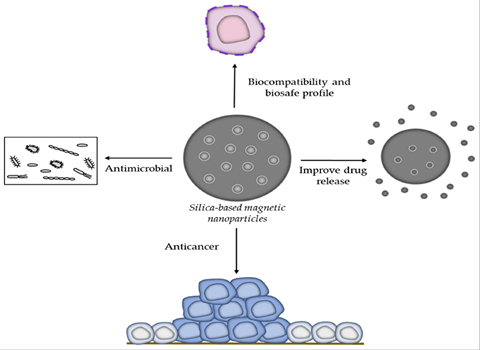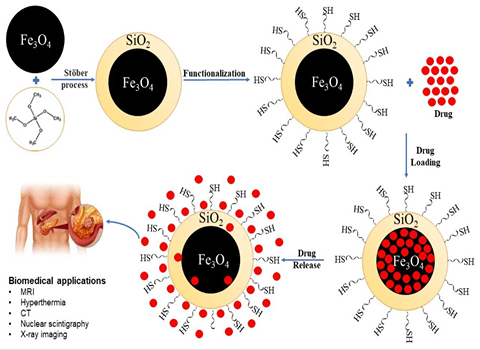Synthesis of Silica Coated Magnetic Nanoparticles: A Key Innovation
The field of nanotechnology has witnessed remarkable advancements in recent years, presenting businesses with a plethora of potential opportunities.
One breakthrough that holds significant promise is the synthesis of silica coated magnetic nanoparticles.
These engineered particles possess a unique combination of properties that make them highly versatile and applicable in various industries.
Commercializing Silica Coated Magnetic Nanoparticles
The synthesis of silica coated magnetic nanoparticles involves a complex process that requires careful attention to detail.
The first step entails the preparation of iron oxide nanoparticles, often in the form of magnetite or maghemite.
These magnetic nanoparticles are then coated with a layer of silica using a sol-gel process, resulting in the formation of silica coated magnetic nanoparticles.
What sets silica coated magnetic nanoparticles apart is their ability to exhibit both magnetic and non-magnetic properties simultaneously.
The magnetic core allows for controlled manipulation and separation of the particles, while the silica shell provides stability and bio-compatibility.
This unique combination enables a wide range of applications across multiple industries.
In the medical field, silica coated magnetic nanoparticles have shown great promise in drug delivery systems.
The magnetic core allows for targeted delivery of therapeutics to specific areas of the body, while the silica shell ensures the stability and controlled release of the encapsulated drugs.
This targeted approach enhances the efficacy of treatments, reduces side effects, and improves patient outcomes.
Another promising area of application is in environmental remediation.
The magnetism of these particles enables their efficient separation from contaminated soil or water, while the silica coating acts as a protective layer, preventing the release of toxins.
By using silica coated magnetic nanoparticles, businesses can effectively remove pollutants and contaminants from the environment, leading to cleaner and safer ecosystems.
Unique properties of silica coated magnetic nanoparticles
Furthermore, the unique properties of silica coated magnetic nanoparticles make them valuable in the field of electronics.
These particles can be used in data storage devices, such as magnetic tapes or hard drives, where their magnetic properties play a crucial role in the recording and retrieval of information.
Additionally, their bio-compatibility makes them suitable for use in biomedical sensors and imaging techniques.
Synthesis and Applications of Silica Coated Magnetic Nanoparticles
The synthesis of silica coated magnetic nanoparticles offers businesses an opportunity to tap into new markets and niche applications.
The versatility and functionality of these particles open doors for innovation and product development across various industries.
However, it is essential for businesses to consider the potential challenges associated with commercial-scale synthesis and production, such as cost-effectiveness and scalability.
In conclusion, the synthesis of silica coated magnetic nanoparticles represents a significant breakthrough in the field of nanotechnology.
These particles possess unique properties that make them highly relevant and adaptable across multiple industries.
The medical field, environmental remediation, and electronics are just a few examples of sectors that can benefit from the innovation of silica coated magnetic nanoparticles.
With careful consideration of the challenges, businesses can capitalize on this emerging technology to drive innovation, create value, and establish a competitive advantage in the marketplace.
Additionally, the synthesis of silica coated magnetic nanoparticles opens up possibilities for novel research and development.
Scientists and researchers can explore new applications and delve deeper into understanding the properties and behavior of these particles.
This could lead to further advancements and breakthroughs in nanotechnology, potentially revolutionizing industries and driving technological progress.
Moreover, the commercialization of silica coated magnetic nanoparticles presents an attractive business opportunity.
As industries become more aware of the benefits and potential applications of these particles, demand is likely to increase.
Companies that can successfully develop scalable and cost-effective synthesis methods will be well-positioned to meet this demand and carve out a significant market share.
Collaboration between academia and industry is crucial for the successful synthesis and commercialization of silica coated magnetic nanoparticles.
By fostering partnerships and knowledge-sharing, businesses can access the expertise and resources needed for effective research, development, and production.
This collaboration can accelerate the innovation process and ensure that the resulting products meet the needs and expectations of end-users.
It is also important to consider the ethical implications of the synthesis of silica coated magnetic nanoparticles.
As with any new technology, it is crucial to prioritize safety and environmental responsibility.
Companies must adhere to stringent regulations and guidelines to ensure that the production and use of these particles do not pose any risks to human health or the environment.
By taking a responsible approach, businesses can safeguard their reputation and contribute to sustainable development.
In summary, the synthesis of silica coated magnetic nanoparticles represents a significant advancement in the field of nanotechnology.
These particles offer unique properties that have the potential to revolutionize industries such as medicine, environmental remediation, and electronics.
While there are challenges to overcome, businesses that can effectively synthesize these particles on a commercial scale can capitalize on the opportunities presented by this innovation.
By fostering collaboration and adhering to ethical standards, companies can drive innovation, create value, and contribute to a more sustainable future.




